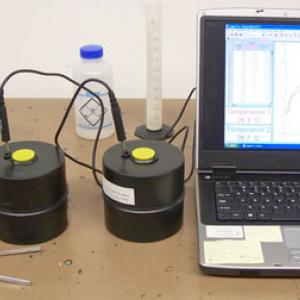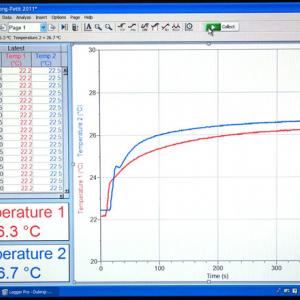College of Liberal Arts & Sciences
4B10.29 - Dulong - Petit Law of Specific Heat
The Dulong-Petit Law states that in particular the metallic elements have approximately the same Molar heat capacity. This is approximately
25 J/mol-deg.
For our experiment we take 1/2 mole of aluminum (13.5g) and 1/2 mole of lead (103.5g) and bring them to the same temperature in boiling water. Take out the metal canister part of the calorimeter and replace it with the Styrofoam cup inserts. Place 40 ml of water in each calorimeter which should have a starting temperature of about 22 degrees C (room temperature). When the samples are dropped into the calorimeter each should show approximately a 5 degree C temperature increase showing that the same number of moles of a metal will give the same temperature increase.
HINT: To keep the sample from touching the thermometer when you drop it into the calorimeter, tilt the calorimeter so the sample drops away from the thermometer.
- Ronald F. Gleeson, "A Sequel to the PSNS Specific Heat Experiment", TPT, Vol. 10, # 7, p. 399, Oct. 1972.
- E. Lagendijk, "A Simple Determination of the Einstein Temperature", AJP, Vol. 68, # 10, p. 961, Oct. 2000.
- John Henry Pepper, "Capacity for Heat", Cyclopadic Science Simplified, p. 164.
- Arthur B. Ellis, Margret J. Geselbracht, Brian J. Johnson, George C. Lisensky, William R. Robinson, "Indirect Evidence for Atoms: Heat Capacities", Teaching General Chemistry - A Materials Science Companion, p. 24.
Disclaimer: These demonstrations are provided only for illustrative use by persons affiliated with The University of Iowa and only under the direction of a trained instructor or physicist. The University of Iowa is not responsible for demonstrations performed by those using their own equipment or who choose to use this reference material for their own purpose. The demonstrations included here are within the public domain and can be found in materials contained in libraries, bookstores, and through electronic sources. Performing all or any portion of any of these demonstrations, with or without revisions not depicted here entails inherent risks. These risks include, without limitation, bodily injury (and possibly death), including risks to health that may be temporary or permanent and that may exacerbate a pre-existing medical condition; and property loss or damage. Anyone performing any part of these demonstrations, even with revisions, knowingly and voluntarily assumes all risks associated with them.

